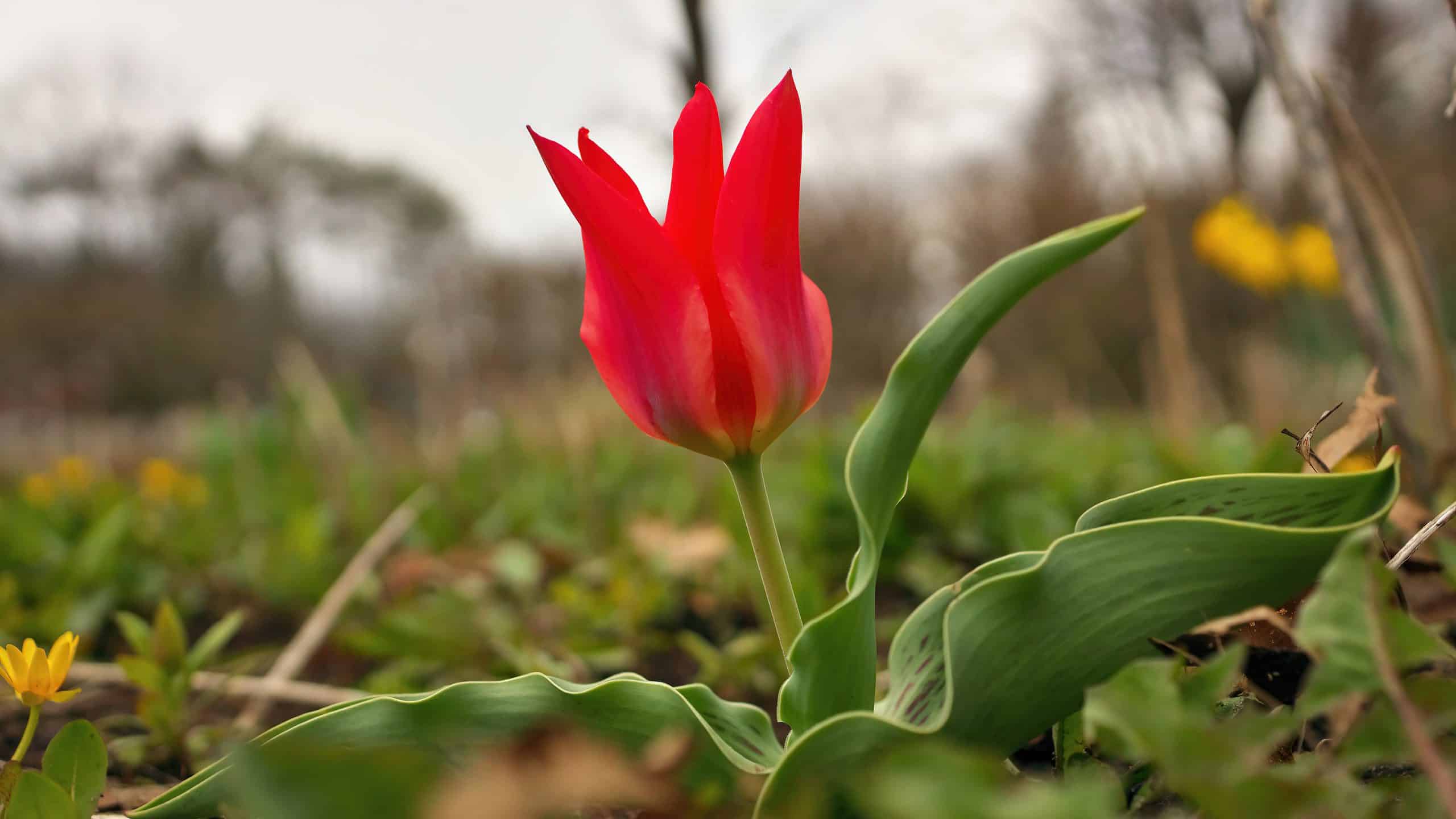Red flowers traditionally symbolize love, and there’s never a better time to show your garden or flower bed some love than after a long, colorless winter. So let’s talk about six red springtime flowers that you, your family, friends, and neighbors, will surely love!
1. Poppy
The poppy is best known for its symbolism of honor and remembrance. This dates back to World War I. More than 8.5 million soldiers died in “The Great War.” The conflict also left the landscape of Western Europe battle-scarred and desolate. But out of those ruins, the red poppy would grow. Thus, the poppy came to symbolize honor and remembrance for those lost in the war and in military conflicts ever since.
These wildflowers are obviously quite tenacious if they could bloom in those harsh battlefield conditions. These flowers will grow in a wide variety of soil conditions and plant hardiness zones. With the exception of the Florida Keys, practically all of the 48 contiguous U.S. states are within the poppy’s growing range.
Poppies require minimal water and no pruning, although deadheading can be helpful to help the plants to thrive for an extended period.
The classic color for poppies is red, but they are also available in a variety of other colors. Select a sunny site to plant these low-maintenance flowers and enjoy their vibrant colors throughout the spring and summer.
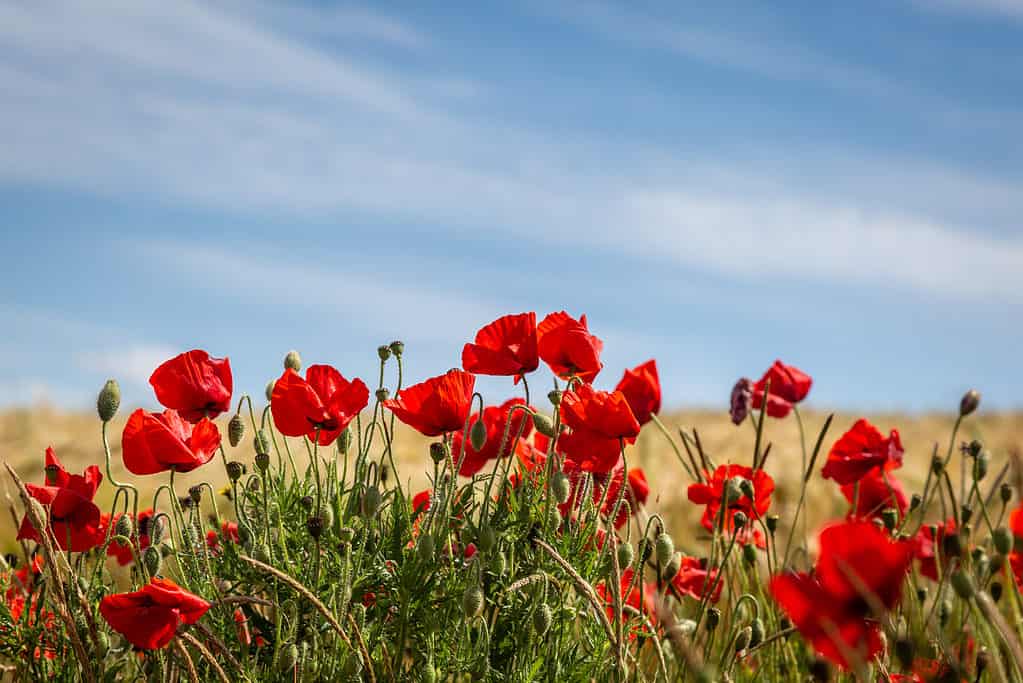
Poppies are tough flowers that grow in a large number of hardiness zones and soil types.
©iStock.com/Lemanieh
| Poppy Facts | |
|---|---|
| Botanical name | Papaver rhoeas |
| Common names | Common poppy, corn rose, corn poppy, red poppy, field poppy, Flanders poppy |
| USDA hardiness zones | 1-10 |
| Sun exposure | Full, partial |
| Mature size | 28 inches tall |
| Bloom time | Spring, summer |
| Flower colors | Red, white, orange, yellow, pink, purple, blue |
| Toxicity | Toxic to pets and humans |
2. Begonias
Begonias are popular late-spring flowers that feature showy blooms that have been traditionally associated with royalty. The Begonia genus includes around 1,500 species and thousands of hybrids. Most begonias that are commercially available today are hybrid varieties.
Begonias cannot tolerate direct sun throughout the day. Therefore, a site that receives the soft sun of morning or evening but is shaded from the harsh sun of the afternoon is ideal.
Water your begonias regularly, but make sure the site is well-drained. Begonias require consistent moisture but can become waterlogged, which may lead to begonia stem rot.
Begonias can perennialize in the warm climates of Zones 10-11, but gardeners in cooler zones can have great success growing them as annuals.
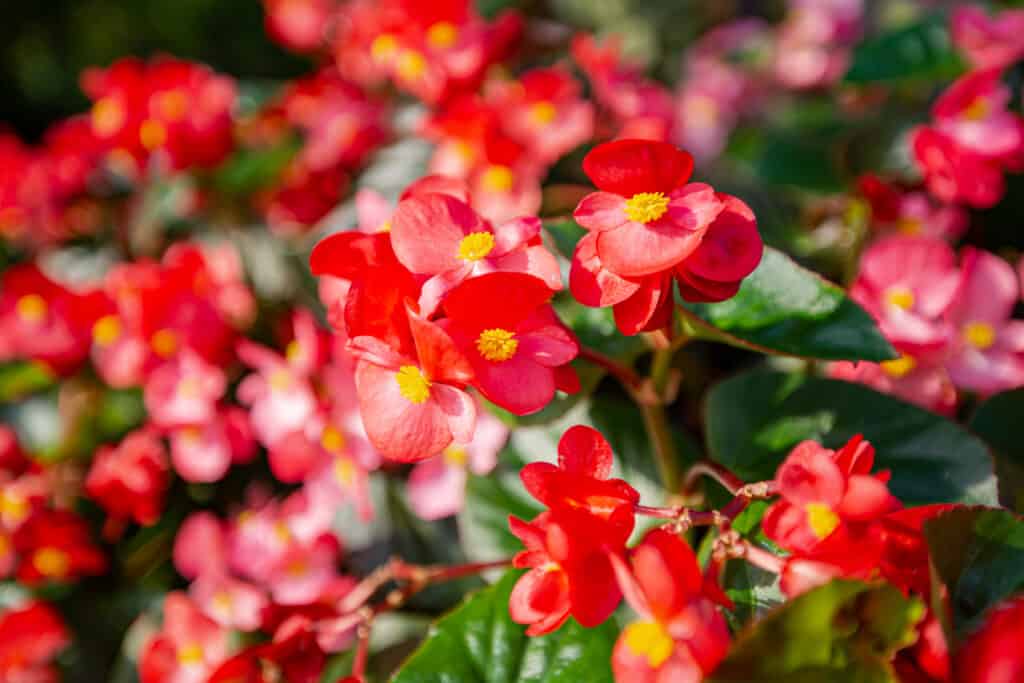
Red begonia needs soft morning sunlight but shade from the harsh afternoon sun.
©iStock.com/deaw59
| Begonia Facts | |
|---|---|
| Botanical name | Begonia spp. |
| Common names | Begonia |
| USDA hardiness zones | 10-11 (when grown as a perennial) |
| Sun exposure | Partial |
| Mature size | 12 inches tall, 12 inches wide |
| Bloom time | Late spring, summer |
| Flower colors | Red, white, pink, bicolor |
| Toxicity | Mildly toxic to pets |
3. Sweet Pea
The sweet pea is a climbing annual that can add a classic old-world feel to your garden. These flowers are normally grown with the support of a trellis or fence, but when those are not available, tripods also work well.
Sweet peas can bloom in a beautiful red, but sweet pea cultivars are available in virtually every color except yellow.
Sow sweet pea seeds directly in late winter or early spring. Plant three seeds together, with approximately one foot between the groups of seeds. For best results, mix compost into the soil six weeks before planting sweet pea seeds.
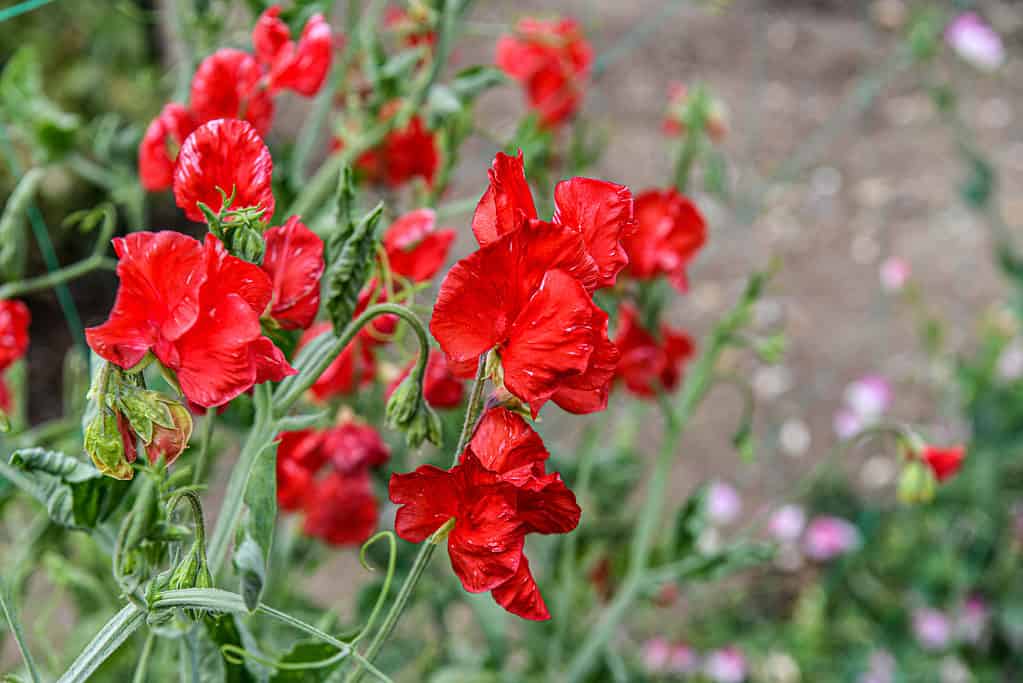
The sweet pea flower comes in a variety of colors, including a lovely deep red.
©Anna Derewacz-Czuprynska/Shutterstock.com
| Sweet Pea Facts | |
|---|---|
| Botanical name | Lathyrus odoratus |
| Common names | Sweet pea, everlasting pea, perennial pea |
| USDA hardiness zones | 3-8 |
| Sun exposure | Full, partial |
| Mature size | 6-8 feet tall |
| Bloom time | Late spring, summer, and fall |
| Flower colors | Red, pink, white, lavender, blue |
| Toxicity | Toxic to humans and pets |
4. Primrose
The Primula genus includes 500+ species and countless cultivars and hybrids. With that many flowers in the genus, it’s not surprising that there is a wide diversity of flower displays. Most varieties feature dark green leaves with vibrant flowers that bloom in the spring atop stout stalks. Some have flower clusters on a single stem. Others feature one flower per stem.
Primroses are among the first flowers to bloom in the spring. The flower’s name derives from the Latin word primus, which means “first.” The primrose has historically been a symbol of optimism, youth, and renewal.
Most primroses prefer partial shade. Some varieties can handle full sun as long as they receive regular watering, but virtually all primroses will thrive in a spot where they are shaded during the hottest part of the day.
Most varieties need consistent watering. Mulch can help the soil retain moisture to help primrose reach its peak potential.
Primroses are available in a wide array of colors, but the deep red primroses with bright yellow centers are among the most eye-catching.
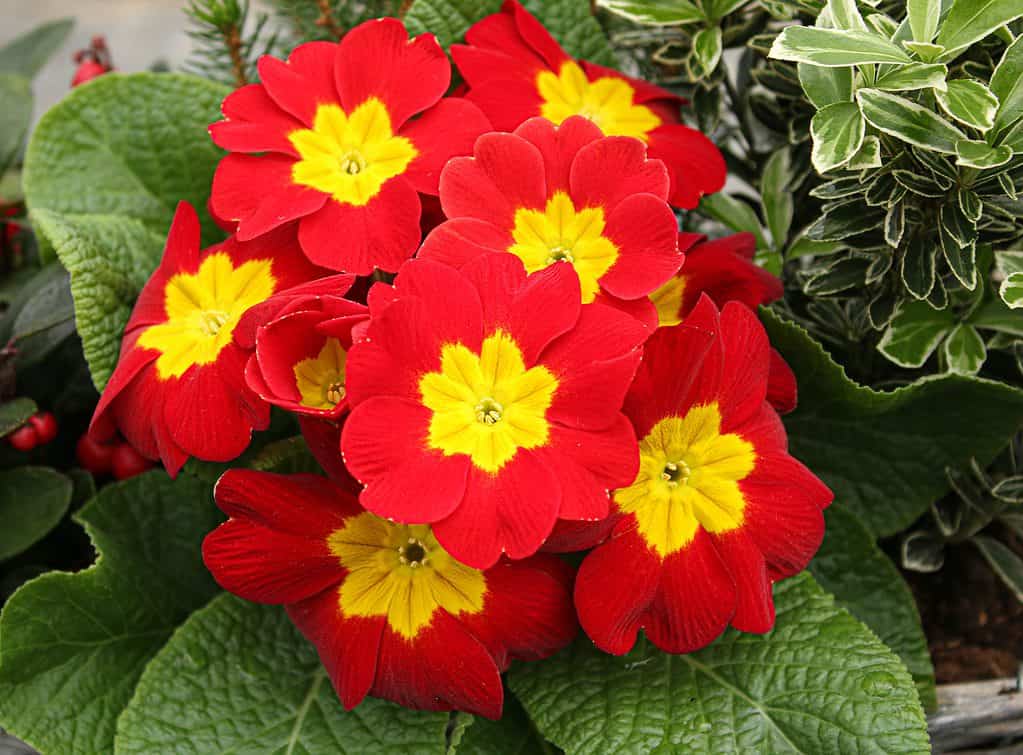
Bright red primroses with vibrant yellow centers are attention-getters, for sure!
©iStock.com/Wirestock
| Primrose Facts | |
|---|---|
| Botanical name | Primula spp. |
| Common names | Primrose, polyanthus |
| USDA hardiness zones | 3-8 |
| Sun exposure | Partial, shade |
| Mature size | 6–20 inches tall, 8–20 inches wide |
| Bloom time | Spring |
| Flower colors | Red, pink, yellow, orange, white, blue, purple |
| Toxicity | Toxic to humans and pets |
5. Tulips
The tulip is truly the king of spring. When tulips begin to blossom, it’s a sure sign that the doldrums of winter are gone, and springtime is upon us.
The Tulipa genus contains approximately 150 species with over 3,000 cultivars and hybrids. These flowers are grouped into 15 different classifications based on shape, height, and bloom time.
The hybridization of tulips has provided a nearly limitless palette of colors that are commercially available today. The red tulip, however, is still among the most classic springtime flowers that can adorn your gardens and beds each spring. Some of the most popular red varieties include Red Riding Hood, Red Emperor, Red Impression, Apeldoorn, Linifolia, Red Dynasty, Miranda, Montana, Red Matador, and Red Purissima roses.
For best results, tulip bulbs should be planted in the fall, 6-8 weeks before the first freeze. The ideal soil temperature for bulb planting is 55°F. This will allow the bulbs to root before the ground freezes.
Tulip bulbs require a cold stratification period to end their dormancy and promote healthy growth. If they are not in the ground through this cold winter period, the blooms will be malformed, or the plants may not grow.
If you live in warmer climates where the soil doesn’t reach or remains at cool temperatures through the winter, you must chill your tulip bulbs before planting.
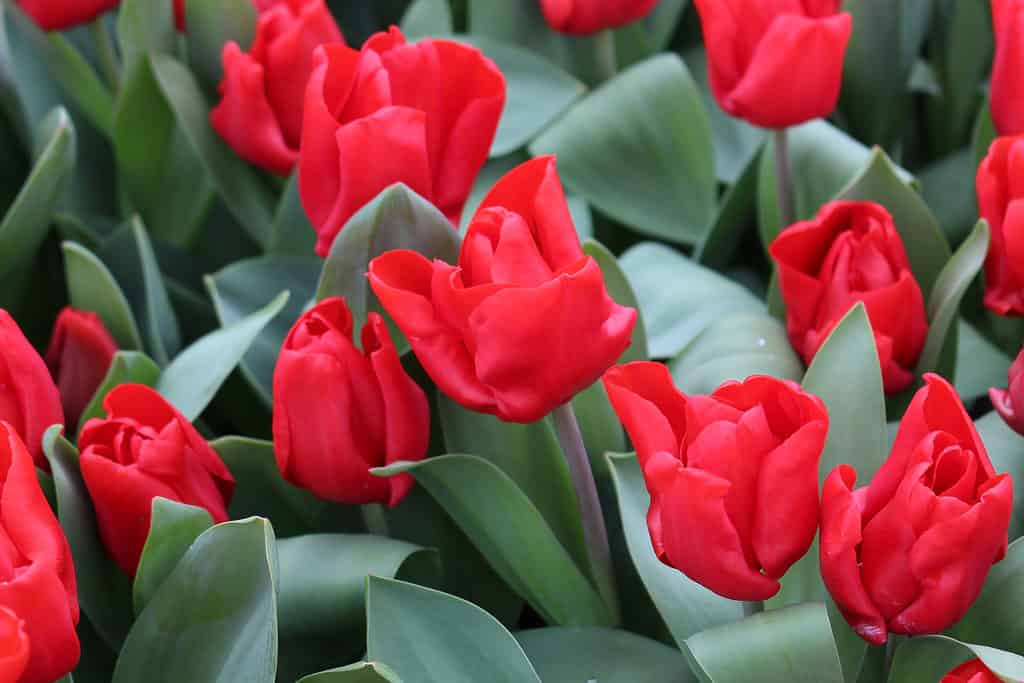
There are tons of red tulip varieties available, including the popular Red Riding Hood tulip.
©Tatiana Alex/Shutterstock.com
| Primrose Facts | |
|---|---|
| Botanical name | Tulipa spp. |
| Common names | Tulip |
| USDA hardiness zones | 3-7 |
| Sun exposure | Full |
| Mature size | 9–24 in. tall, 6–9 in. wide |
| Bloom time | Spring |
| Flower colors | Red, pink, yellow, orange, purple, black, green, white, multicolor |
| Toxicity | Toxic to humans and pets |
Hyacinths
The common name “hyacinth” is normally applied to both the Hyacinthus and Muscari genera. While not actually related, the plants share many similarities, both in the appearance and care of the flowers. For this reason, flowers in these two genera are all normally referred to as hyacinths.
Hyacinths come in a rainbow of colors. Red hyacinths have traditionally symbolized play and whimsy. If you want to add a playful touch to your springtime garden, red hyacinths are plentiful at local nurseries and gardening centers.
Similar to tulips, hyacinth bulbs should be planted approximately eight weeks before the first frost in the fall is expected. Choose a sun-drenched spot with good drainage and add some 10-10-10 bulb fertilizer at planting. Then get ready to enjoy your gorgeous red hyacinths in the spring!

Red hyacinths can add a whimsical touch to your springtime garden!
©Sergey V Kalyakin/Shutterstock.com
| Hyacinth Facts | |
|---|---|
| Botanical name | Hyacinthus orientalis |
| Common names | Hyacinth, Common Hyacinth, Dutch Hyacinth, Garden Hyacinth |
| USDA hardiness zones | 4-8 |
| Sun exposure | Full, partial |
| Mature size | 6-12 inches tall, 3-6 inches wide |
| Bloom time | Spring |
| Flower colors | Red, pink, white, blue, purple |
| Toxicity | Toxic to pets and humans |
Thank you for reading! Have some feedback for us? Contact the AZ Animals editorial team.

